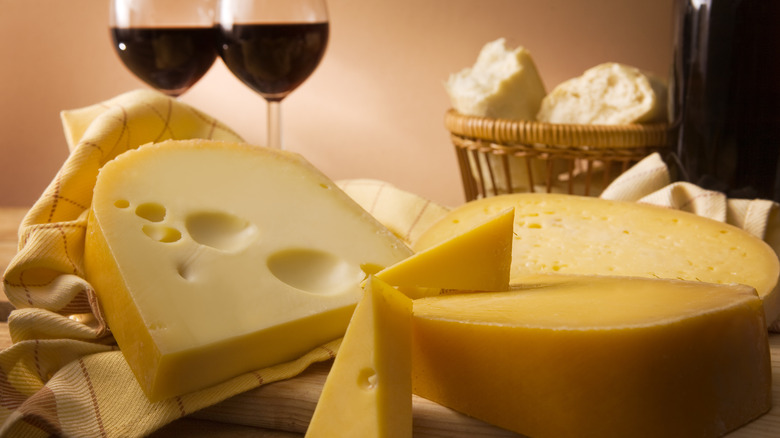The Differences Between Semi-Firm And Firm Cheeses
Cheese can be categorized by a number of different descriptors: aged vs. fresh, mild vs. sharp. One common way to distinguish between cheeses is by texture. Goat cheese, Camembert, Brie — these would all be considered soft cheeses, while varieties like Gruyère and Pecorino are categorized as hard or firm. But what about the cheeses that fall in between? What makes a "semi-firm" cheese different from its firm or soft cousins?
Cheese firmness has everything to do with moisture content, aging time (or lack thereof), and the development of curds during the cheesemaking process. Firm cheeses are pressed thoroughly and tend to have small curds, resulting in as little moisture as possible in the final product. They also go through a lengthier aging process, further developing flavor and drying the cheese out.
Semi-firm cheese, also known as "semi-hard cheese," sits in the middle of the soft and hard varieties with pressing curds (but not too much) and then aging for a shorter period of time (one to six months versus upwards of thirty months). Some semi-hard cheeses are coated in wax to avoid needing to be brined and aged longer, such as Gouda.
Types of semi-firm cheese
What types of cheese count as "semi-firm"? One of the most popular semi-firm cheeses is Gouda, a Dutch cheese made from cow's milk that has a mild, creamy, and subtly sweet taste. Typically made with a wax rind, this cheese is an excellent cooking cheese and goes well on sandwiches, especially grilled cheese. Some varieties of Gouda are smoked which gives a subtle, complex smoky flavor to the cheese and makes it an excellent pairing for fruits, such as apples and pears.
Other popular semi-firm cheeses include Monterey Jack, an American cheese made from cow's milk with a buttery flavor that's excellent for topping burgers or grating into quesadillas. Provolone and Havarti, both also made from cow's milk (most semi-soft cheeses are made with cow's milk due to the butterfat content), are often seen at deli counters and their smooth, mild flavors make them great on picnic sandwiches, especially paired with sliced turkey or ham.
How to use semi-firm vs. firm cheeses
Semi-firm cheeses shoulder a lot of work in the cheese world — with a moderate texture that's good for melting, grating, and slicing, you can work semi-firm cheeses into many different contexts and recipes. Semi-firm cheeses are the best types of cheeses for sandwich slices, for melting on burgers, for turning into cheesy dips, and for stirring into macaroni and cheese. These cheeses can also be served plain with little fuss; they are easily cubed and added to any cheese board without needing special serving utensils (just a toothpick will do).
Hard cheeses, on the other hand, tend to have more specific uses. You can certainly eat Parmesan and Pecorino by themselves, but typically, these cheeses are grated and melted into sauces or used to top plates of pasta. Cheeses like Gruyère are used to top baked dishes, such as French onion soup. Each cheese has a place at the table — learn which styles work best with which application and you'll have a delicious outcome every time.


